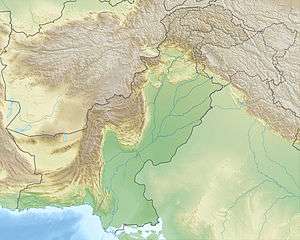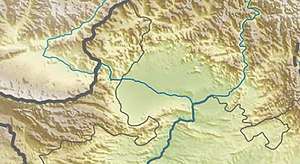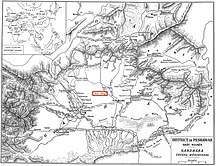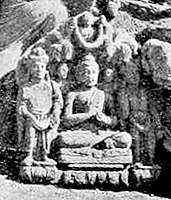Seri Bahlol
Seri Bahlol (Urdu: سری بہلول), also Sahr-i Bahlol or Sahri Bahlol, is a city and archaeological site located near Takht-i-Bahi, in Mardan District, about 70 kilometer north-west of Peshawar, Khyber Pakhtunkhwa, Pakistan.
| UNESCO World Heritage Site | |
|---|---|
| Location | Mardan District, Khyber Pakhtunkhwa, Pakistan, |
| Part of | Buddhist Ruins of Takht-i-Bahi and Neighbouring City Remains at Seri Bahlol |
| Criteria | Cultural: (iv) |
| Reference | 140-002 |
| Inscription | 1980 (4th session) |
| Coordinates | 34°15′19.71″N 71°57′02.48″E |
 Location of Seri Bahlol in Pakistan  Seri Bahlol (Gandhara) | |
History

Seri Bahlol is a historical place and it has been included in the UNESCO World Heritage List since 1980.[1] The ruins of Seri Bahlol are the remnants of a small ancient fortified town built during the Kushan period.[1][2] The city was protected during the time of John Marshall.[3]
It contains the remains of Buddha, which have not been properly excavated. Antiques such as statues, coins, utensils and jewellery are commonly found.[4] The local people continue illegal excavation in their homes and land, damaging the historical monuments. Some of the local dealers of antiques misguide the local population and instigate them to involve in illegal excavation. It requires national and international attention in order to reserve the remnants at Seri Bahlol.[1]
The word "Seri Bahlol" has been explained by various people in different ways. The local people, however, explains that this is a combination of two Hindi words "Sheri" means Sir and "Bahlol" the name of a prominent political and religious leader of the area. However, the name is not as old as the village Seri Bahlol. The village is located on a hillock protected by a well sophisticated stone wall which was constructed under the Kushans.[1] The wall is damaged in several places, but it is still visible in many places. The village is surrounded by fertile land where local people practice agriculture. For the last few years, the rapid population growth has engulfed the agriculture land which is a risk for food security.
Gallery
 A farmer applying pesticides to his crop
A farmer applying pesticides to his crop A view of the village
A view of the village Excavations in 1911-1912.
Excavations in 1911-1912..jpg) Meditating Bodhisattva. Schist. Sahr-i-Bahlol. Patna Museum
Meditating Bodhisattva. Schist. Sahr-i-Bahlol. Patna Museum
 Preaching Buddha.
Preaching Buddha.- Head of a bodhisattva.
 Bodhisattva.
Bodhisattva.%2C_from_Sahribahlol._Indian_Museum%2C_Calcutta_ei05-34.jpg) Standing Bodhisattva.
Standing Bodhisattva. Buddha statues.
Buddha statues.
 Seated Buddha triad, Sahri Bahlol excavations, 1911-1912.
Seated Buddha triad, Sahri Bahlol excavations, 1911-1912..jpg) Great Buddha of Sahri Bahlol 1909 excavation (upright)
Great Buddha of Sahri Bahlol 1909 excavation (upright) Sahri Bahlol Buddha, excavated 1909-1910, Peshawar Museum
Sahri Bahlol Buddha, excavated 1909-1910, Peshawar Museum Bronze Buddha image, British Museum.
Bronze Buddha image, British Museum.
See also
| Wikimedia Commons has media related to Seri Bahlol. |
- Hindu and Buddhist architectural heritage of Pakistan
- List of UNESCO World Heritage Sites in Pakistan
References
- Unesco
- Katariya, Adesh (2012). The Glorious History of Kushana Empire: Kushana Gurjar History. Retrieved 2 December 2017.
- Conserving Fortified Heritage: The Proceedings of the 1st International Conference on Fortifications and World Heritage. Cambridge Scholars Publishing. 2016. ISBN 9781443896375. Retrieved 2 December 2017.
- Hassan Dani, Dr: The Peshawar
- FUSSMAN, Gérard (1974). "Documents Epigraphiques Kouchans". Bulletin de l'École française d'Extrême-Orient. 61: 54–57. ISSN 0336-1519. JSTOR 43732476.
- Rhi, Juhyung. Identifying Several Visual Types of Gandharan Buddha Images. Archives of Asian Art 58 (2008). pp. 53–56.
- The Classical Art Research Centre, University of Oxford (2018). Problems of Chronology in Gandhāran Art: Proceedings of the First International Workshop of the Gandhāra Connections Project, University of Oxford, 23rd-24th March, 2017. Archaeopress. p. 45, notes 28, 29.
